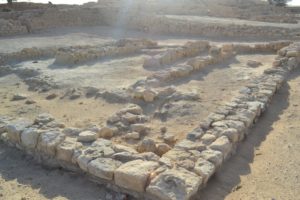
3rd Period of Biblical History
Israelite Period
1000 BCE – 600 BCE
Sponsored By: Gregory & Kathleen Bekes
Escanaba, Michigan, USA
As always, Tamar remained a perennial source of water to be enjoyed by everyone, including Edomites and Moabites, as well as the “Children of Abraham,” known to their neighbors as Israelites, after Jacob’s name had been changed to Israel centuries beforehand.
But in the south it was the tribe of Judah who became “Jews” to the rest of the world and heirs to the most memorable of all Jewish kingdoms, at first ruled by Saul, and then, it seems, by none other than David and Solomon. Under their leadership, within the boundaries of a newly unified nation, Tamar became much more than a desert oasis. It was now an outpost, fortified for defensive purposes, and strategically positioned, not only to monitor caravans traveling to and from distant cities, but to protect copper mines at Faynan, near Eilat.
Archeological remains confirm that “Solomon… built Tamar (Tadmor) in the wilderness, within the land…of his dominion” (I Kings 9:19) and that three hundred years later King Josiah may have been the one who destroyed the pagan altar being used there at the time. “Behold, the altar shall be rent, and the ashes that are upon it shall be poured out” (I Kings 13:3).
 Remains from Tamar during the Israelite Period.
Remains from Tamar during the Israelite Period.
Next: Greco-Roman Period
Seven Historic Periods of Israel
Abrahamic Period
2000 – 1350 BCE - learn more
Moses Period
1350 – 1000 BCE - learn more
Israelite Period
1000 – 586 BCE learn more
Greco-Roman Period
586 BCE – 638 CE - learn more
Medieval Period
638 – 1918 CE - learn more
British Period
1918 – 1948 CE - learn more
Israeli Period
1948 – to present - learn more
